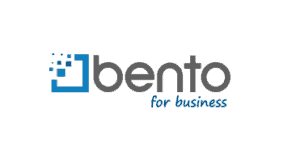Managing multiple projects may be a good problem to have, but it can still be a problem—especially for the back-office overhead. Inefficiencies that crop up and tools that can be used to manage projects can increase overhead, slowing your business down if you aren’t careful.
Bento for Business works with thousands of small businesses across the United States, and has collected their tips and spent management strategies for keeping their operations fit and agile. The following identifies seven techniques that may spark ideas on how to be more profitable by better organizing your workload, managing cash flow, and understanding spending patterns. You may already be familiar with some of the best practices covered here, but a reminder may help you apply them in new or different ways.
1) Use software to organize your projects and organize your software
There seems to be an endless supply of cloud-based apps to help you organize your workflow. Once you have a clear understanding of what you need to organize, and you select a suitable solution, you will likely notice an improvement in your project organization for nothing more than the cost of the software subscription. The ability to collaborate across your team, to share files, to automate tasks and to track and organize documents will minimize administrative overhead. This could result in more growth-focused work efforts and possibly less overtime hours.
The ease of access and purchasing comes with a catch: you may be paying for things you have forgotten about or no longer need. Bento customers recommend conducting a periodic audit of your subscription charges to determine if you have duplicate, unused or underutilized software services. Virtual cards are an easy way to keep your subscription costs contained, organized, and trackable. You can dedicate one virtual card for software subscriptions to keep these repeated purchases separate from other company spending. Alternately, you could use one virtual card for each service, then cancel the card when you no longer need that service or to prevent automatic billing after starting a free trial.
2) Examine the flow of the work relative to the team members and equipment
Managing resources is complex and critical. For example, if one piece of equipment is needed for multiple uses on one job, some team members may be unproductive while they wait for it to be free. On the other hand, if an expensive device is not being used, its costs still hit your overhead and can reduce your profitability. The worst case is when some equipment is not being used because others are overused.
Like equipment, people are subject to being under- and over-used, leading to unnecessary expenses or burnout. If you can identify potential areas of burnout, you can take steps to prevent it and save you the headaches and overhead costs involved.
Tip for equipment: Set, keep, and track equipment maintenance schedules. One Bento for Business customer, Precision Facility Services of San Antonio, Texas, found that a spending analysis showed the timing and cost of breakdowns. This helps them schedule preventive maintenance, which is less expensive and reduces project delays.
Tip for staff: Recognize what motivates your team and find ways to motivate them on a regular basis. Bring in treats, take them out to a local ball game, have a barbecue. Simple, low-cost investments may take time and energy but the return far outweighs the risk of burnout or turnover.
3) Analyze cost allocation
The Project Management Institute has researched the issues of costs and cost allocation. There are many factors that go into how businesses set their allocations, but let’s face it, sometimes costs are put into general overhead because it is easier than trying to determine where they should go. This is unfortunate, because better cost allocation can reduce overhead while improving bidding accuracy.
One thing that can help is managing your business payments in one place. Simplified management makes it easier to see who is spending money, on what, and where. Some organizations do this by using the same payment system for every vendor. While this may be efficient, it can also be very expensive. For example, writing checks is time consuming and may open you up to error and fraud. Automated clearing house (ACH) can be costly and slow. And, not all vendors accept credit cards.
Bento’s customers, on the other hand, use the Bento platform to keep all spending information in one place, while using the method that is the most appropriate form of payment for their specific spending needs. Bento for Business offers a range of payment types, including ACH transfer, debit cards, and, our newest capability, email payments. By keeping all payments in one system, Bento customers do not have to review multiple sources of spending. This simplification allows them to reduce time, costs and overhead.
Precision Facility Services found that using Bento not only eliminated its time-consuming manual accounting processes, but also helped it identify where money was being spent so that it could be controlled. The improved efficiency freed up the financial staff to analyze spending, and what they found they could put to work saving the company money. In fact, they report savings of nearly $30,000 in their first six months with Bento. This allowed it to improve its costing data so that it could place more competitive bids.
4) Use separate debit or credit cards for back-office and project expenses
One way to manage projects better and keep an eye on business overhead is to use separate payment cards for the different parts of the business. The cards used to cover project-based expenses can be separate from those used for office expenses to prevent leakage. Bento for Business virtual cards for online purchases for new projects.
Nuvia Water Technologies of Corona, California, had been using traditional bank credit cards for both its back-office and field employees. The charges that came through were not tied to specific projects, and there was enough misuse that the staff spent at least a half-hour every day reviewing transactions. Nuvia then eliminated corporate cards and had employees use personal funds for expenses, then submit receipts for reimbursement, but the reduction in unauthorized expenses was more than offset by increased time spent processing expenses. By switching to Bento cards, Nuvia was able to empower employees to spend as needed to get their work done, and management could better see which expenditures were made by the office and which were related to field activities.
5) Put an intern to good use
Of course, you know you need to organize your projects. You know there are apps that can make it easier. What you don’t have is the time to actually figure out which apps are best for what you want to do or how to set up the app once you decide on it.
This is a good project for an intern. You can give a student the assignment of researching different apps and presenting which ones could be best for your business based on your requirements. This is a project with a specific beginning and end, so the intern’s work won’t be ignored when their assignment ends. Interns allow you to give back to your community while getting important, short-term work done by eager, willing talent. It may be possible to structure the work so that the intern qualifies for college credit, further reducing your cost. Some businesses have opened their internship program to people returning to the workforce after a gap, or someone wanting to explore new roles in new fields.
Bento for Business hires interns for specific projects, which can help gain insights into customers and build operational efficiencies. For example, this summer, an intern pulled together a detailed template for the events involved with product launches. This combined the tacit knowledge of several staff members with industry best practices, which ultimately produced a standard process, customized to our needs and transferable among employees.
For Bento and its customers running similar internship programs, there is one essential key to success: define the project upfront—provide a clear start and end time, specific deliverables and team members assigned to help.
6) Simplify payment of subcontractors and suppliers
All Bento customers can agree on one thing: it can be a pain to collect, store and find invoices, then get payments sent out on time. Suppliers communicate via email, text and mail, and the messages end up stored in storage cabinets, inboxes, desktops (virtual and physical) and computer drives.
Paper checks are popular, but they add costs—supplies and postage alone add to overhead, especially on a project that has a one-off supplier. It is also dependent on vendor practices. Some vendors and subcontractors are better about getting payment information out than others. An artisan providing a custom finish may perform superb work, but might not not have the best billing system.
Once you can build a simple, streamlined process for the collection and storing of invoices, your ability to focus on simplifying payment options becomes infinitely easier. Using a solution like Bento, which includes a unique B2B email payment feature, eliminates the need to figure out which vendor wants to be paid using which mechanism and helps you track all payments in one place. You can email your vendors from the Bento platform and have them choose how to be paid—no more hunting down bank information and spending time writing and mailing checks.
7) Look for shared resources, either to reduce project costs or to better negotiate with vendors
One huge advantage of automating your expense and expenditure programs is that you get a clear picture of where people are spending money. Instead of reading through paper expense forms or looking at reports by accounting line item, you can see vendor names in real time. When you see where you spend money, you are in a better position to negotiate preferred vendor deals or identify partnership opportunities. And, you can see areas of duplication that can be eliminated, reducing your overhead.
Bento customers have reported that this visibility on spending has helped them understand their areas of expenditure more clearly and quickly. Bento cards can be restricted by purchase categories, amount, days of the week and more, helping you enforce any preferred expense policies.
Bento for Business saves you money and increases efficiency, ultimately making your business more successful. Sign up for a personalized demo to see for yourself.
Find out more:
- Learn how to get started in exporting.
- Get a 60-day free trial.
- Have questions? Get answers with a personalized demo.






